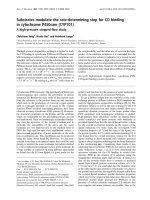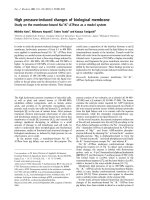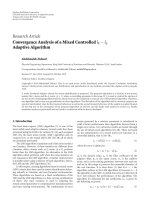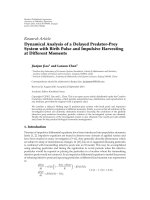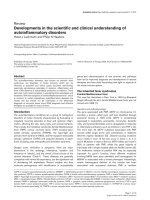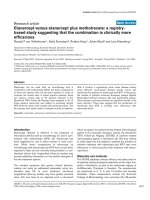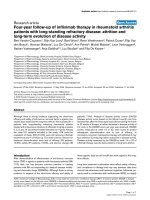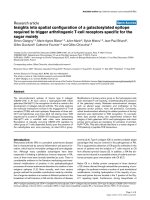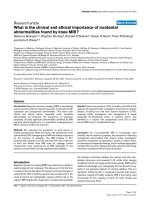Báo cáo y học: " Study protocol: The development of a pilot study employing a randomised controlled design to investigate the feasibility and effects of a peer support program following discharge from a specialist first-episode " pdf
Bạn đang xem bản rút gọn của tài liệu. Xem và tải ngay bản đầy đủ của tài liệu tại đây (401.24 KB, 7 trang )
Robinson et al. BMC Psychiatry 2010, 10:37
/>Open Access
STUDY PROTOCOL
BioMed Central
© 2010 Robinson et al; licensee BioMed Central Ltd. This is an Open Access article distributed under the terms of the Creative Commons
Attribution License ( which permits unrestricted use, distribution, and reproduction in
any medium, provided the original work is properly cited.
Study protocol
Study protocol: The development of a pilot study
employing a randomised controlled design to
investigate the feasibility and effects of a peer
support program following discharge from a
specialist first-episode psychosis treatment centre
Jo Robinson*, Annie Bruxner, Susy Harrigan, Sarah Bendall, Eoin Killackey, Vittoria Tonin, Katherine Monson,
Melissa Thurley, Shona Francey and Alison R Yung
Abstract
Background: Young people with first-episode psychosis (FEP) are at risk of a range of negative outcomes. Specialist
FEP services have been developed to provide comprehensive, multi-disciplinary treatment. However, these services are
often available for a restricted period and the services that young people may be transferred to are less comprehensive.
This represents a risk of drop out from treatment services in a group already considered to be at risk of disengagement.
Peer support groups have been shown to improve social relationships among people with psychosis however
individual peer support programs have not been tested on young people with first-episode psychosis; nor have they
been tested at the point of discharge from services.
Methods/design: The study is an 18-month randomised controlled trial being conducted at Orygen Youth Health
Research Centre in Melbourne, Australia. The aim of the study is to test the feasibility and effects of a 6-month peer
support intervention delivered to young people with FEP over the period of discharge. Participants are young people
aged 15-24 who are being discharged from a specialist first-episode psychosis treatment centre. There is a 6-month
recruitment period. The intervention comprises two hours of contact per fortnight during which peer support workers
can assist participants to engage with their new services, or other social and community activities. Participants will be
assessed at baseline and post intervention (6 months).
Discussion: This paper describes the development of a randomised-controlled trial which aims to pilot a peer support
program among young people who are being discharged from a specialist FEP treatment centre. If effective, the
intervention could lead to benefits not only for participants over the discharge period, but for peer support workers as
well.
Trial registration: The study was registered with the Australian New Zealand Clinical Trials Registry; number:
ACTRN12610000241033.
Background
Young people with first-episode psychosis (FEP) are at
risk of a range of negative outcomes both in clinical terms
and with regard to their general and social and vocational
functioning. Specialist FEP services have been developed
to provide comprehensive, multi-disciplinary treatment
of the medical, social, psychological, family, educational
and vocational aspects of the experience of FEP, in order
to help young people to recover from psychosis. How-
ever, these services are often available for a restricted
* Correspondence:
1
Orygen Youth Health Research Centre, Centre for Youth Mental Health,
Department of Psychiatry, University of Melbourne, Locked Bag 10, 35 Poplar
Road, Parkville, Victoria 3052, Australia
Full list of author information is available at the end of the article
Robinson et al. BMC Psychiatry 2010, 10:37
/>Page 2 of 7
period and the services that young people may be trans-
ferred on to are less comprehensive. This represents a
risk of drop out from treatment services in a group
already considered to be at risk of disengagement from
services [1]. A goal of a FEP service should be to manage
the transition to a new service to ensure good engage-
ment with the new service, which it is hoped would lead
to improved treatment outcomes.
Individuals with FEP are also at high risk of suicide and
suicide attempt (SA). Rates of suicide are estimated at
between 1 and 3% over a 4 to 5-year follow-up period
[2,3]. Rates of deliberate self-harm (DSH) and SA are
higher; between 10% and 14% of people with FEP report
either DSH or a SA prior to presentation for treatment
[4,5,2]. Rates remain high following the commencement
of treatment. One-year prevalence rates of SA range from
2.9% to 11% [4,6,7]. Longer term follow-up studies have
reported a 2-year prevalence rate of 11.3% [8] and a 4-
year prevalence rate of 18.2% [2].
Evidence also tells us that the strongest predictor of
future suicide and SA is a previous attempt [9,3]. Other
key risk factors include depressive symptoms and recent
discharge from hospital [7,10-13]. One way to reduce the
risk of suicide at discharge is to provide an enhanced sup-
port system for the young person throughout the dis-
charge process and peer support may be ideal in this area.
The concept of peer support is based on the notion that
people who have experienced and overcome a particular
type of adversity can be a useful source of support,
encouragement and hope to others experiencing similar
situations [14]. A survey of consumer perspectives on the
management of psychiatric emergencies identified peer
support as a future priority for use in emergency settings
[15]. A further study tested the effect of peer support
groups on people with psychosis [16] and although this
lead to an improvement in the social relationships of par-
ticipants, it was limited in several ways. Firstly, it was not
tested specifically with young people with FEP. Secondly,
it was not conducted at the point of discharge. Thirdly,
the authors did not look at suicidality as an outcome of
interest, and fourthly, it was a group and not an individual
intervention.
It has been concluded that whilst peer support appears
to have become a popular addition to mental health ser-
vices and has the potential to be an important component
of mental health care, it is to date under-researched [14].
Further, to our knowledge, it is not yet known what the
essential components would be when delivering a peer
support program to young people with FEP over the
period of discharge from a specialist service. Nor do we
know if it is feasible to expect young people who are in
recovery themselves to support other young people at
this vulnerable time.
Methods/design
Aims and hypotheses
The overall aims of this study are to test the feasibility
and effects of a 6-month peer support intervention deliv-
ered to young people with FEP from approximately 3
months prior to discharge from a specialist treatment ser-
vice, and continuing for 3 months post-discharge. We
also aim to identify what participants want from a peer
support program at this time. If the program proves
effective and acceptable to participants, we aim to
develop a treatment manual to support future programs.
The hypotheses are that when compared to treatment
as usual (TAU) the peer support intervention will lead to:
1. Increased engagement and treatment adherence
among people being discharged from the Early Psychosis
Prevention Intervention Centre (EPPIC) and who are
being referred on to alternative services; 2. Increased per-
ceived social support; 3. Increased quantity and improved
quality of information provided; 4. Increased service sat-
isfaction; 5. Reduced risk of suicide; and 6. High levels of
satisfaction with peer support role for recipients and peer
support workers.
Study design
The study is a randomised controlled trial registered with
the Australian New Zealand Clinical Trials Registry and
approved by the North Western Mental Health Research
and Ethics Committee.
Setting
Orygen Youth Health Research Centre (OYHRC) is a
publicly funded specialist mental health service for peo-
ple aged 15-24 living in the Western and North western
regions of Melbourne with an integrated research centre.
The service treats individuals with both psychotic and
non-psychotic disorders. There is also a youth participa-
tion program which comprises consumer advocacy, con-
sultation, public speaking, a drop in room and a peer
support program. The peer support program currently
offers peer support to young people on the inpatient unit.
This study will see an extension of the peer support pro-
gram to include the period leading up to and immediately
following discharge from the service. The current study
will take place in EPPIC and represents a partnership
between EPPIC, the Orygen research centre and the
youth participation program.
Participants
Participants will be approximately 36 young people, aged
15-24, who are being discharged from EPPIC. There are
currently around 300 young people registered with
EPPIC, between 10 and 20 of whom are discharged per
month. For the purpose of the study protocol we have
assumed that on average 12 people will be discharged per
Robinson et al. BMC Psychiatry 2010, 10:37
/>Page 3 of 7
month and that 50% (n = 6) will consent to participate.
This would mean that 3 people would be recruited to the
treatment group and 3 people would be recruited to the
control group per month. The study has a 6-month
recruitment period which would give us a sample of
approximately 36, 18 in the treatment and 18 in the con-
trol group. It is anticipated that the sample would be
reduced by follow-up attrition, resulting in an approxi-
mate final study sample of 28-31 subjects. Please see Fig-
ure 1.
Procedure
The study team comprises researchers and representa-
tives from the clinical program. The research assistant
(RA) will attend the regular clinical meetings held at
EPPIC in order to identify young people who are about to
commence the discharge planning period. Once the dis-
charge planning process is about to begin the RA will
contact the young person and see if they are interested in
the study. If so they will obtain written consent and con-
duct the baseline assessment (see below). They will also
provide written information for the participant to keep,
which explains the nature of the intervention and pro-
vides contact details for the research team.
Once the baseline assessment is complete the young
person's details will be passed to an independent statisti-
cian (SH) who will randomise them into either the treat-
ment or control group using randomly permuted blocks
of varying size, to help ensure that subject allocation to
the treatment groups is approximately equal. Once ran-
domisation has taken place the statistician will contact
the project coordinator (JR) who will provide the relevant
details to the peer support coordinator (MT/VT) in order
that the intervention can begin. The peer support coordi-
nator will then allocate a peer support worker (PSW).
The first meeting between the PSW and the participant
will take place on-site with the case manager and the peer
support coordinator present. The nature of the interven-
tion will be explained again and both the participant and
PSW will sign a prepared document to indicate that they
fully understand the terms of the intervention.
Intervention
Those participants randomised to the treatment group
will receive treatment as usual plus the peer support
intervention. The intervention will be delivered by the
peer support workers from the point that discharge plan-
ning commences until 3 months after discharge from the
service. It is anticipated that this will be around 6 months
in most cases. The intervention will adopt a befriending
model and will comprise an in-reach and out-reach ser-
vice whereby participants will have a nominated PSW
who they can visit at the drop-in centre at OYH or who
they can meet off-site for support sessions. The PSW will
accompany young people to GP or other health appoint-
ments, help them to locate information about mental
health services and social groups, and help them find
ways to ensure good mental health once the program is
over. A total of 2 hours contact per fortnight of contact
will be offered.
A phased intervention approach will be adopted
whereby contact in the initial and final months will be
minimal compared to the time around discharge. During
the first two months (initial phase) the PSW will work on
building rapport, developing and maintaining contact,
and assisting the young person with mental health issues
and service information. It is expected that most contact
will be in-service as the young person will still be attend-
ing EPPIC. This will allow for more face-to-face contact
which is important to the development of a 'buddy' rela-
tionship. Nearing the discharge period and shortly after
(mid-phase) it is expected that the PSW will assist the
young person in their transition to a new service. PSWs
will be available to escort the young person to the new
service, assist them with attending sessions, understand-
ing health services (including the broader mental health
service), and motivating the young person to consider
supports and contacts for the future. This period of the
intervention will be the most intensive and important for
ensuring treatment engagement and harm minimisation.
The PSW and young person will negotiate when and how
to allocate their 2 hours per fortnight and it is anticipated
that while most time will be spent face-to-face, a small
proportion will also be allocated to phone and email con-
tact. The final phase of the intervention will involve the
PSW 'weaning' the young person from the support of the
PSW by encouraging the young person to be proactive in
managing their mental health. Unlike the initial phase,
most contact in the final stage will be conducted via
phone or email and will focus on encouraging the young
person to develop other new (preferably social) contacts
and supports. The young person will be reminded that at
the cessation of the study they will no longer be able to
rely on the PSW for support.
One of the aims of the study is to identify what young
people actually want from a peer support program there-
fore the protocol will be necessarily flexible in order that
the intervention can meet the individual needs of the par-
ticipants. The PSW will be required to record all contacts
in a log book and this information together with partici-
pant and PSW feedback will inform the development of
an intervention manual for future use.
Control intervention
Those in the control group will receive TAU.
Robinson et al. BMC Psychiatry 2010, 10:37
/>Page 4 of 7
Figure 1 Study flow-chart: This figure displays the participant flow-chart.
WĂƌƚŝĐŝƉĂŶƚƐǁŝƚŚĨŝƌƐƚͲĞƉŝƐŽĚĞ
ƉƐLJĐŚŽƐŝƐƌĞĐĞŝǀĞƚƌĞĂƚŵĞŶƚ
ĨƌŽŵWW/
dŚĞƌĞƐĞĂƌĐŚĂƐƐŝƐƚĂŶƚůŝĂŝƐĞƐǁŝƚŚ
ĐĂƐĞŵĂŶĂŐĞƌƐĂŶĚĐŽŶƚĂĐƚƐƚŚŽƐĞ
LJŽƵŶŐƉĞŽƉůĞǁŚŽĂƌĞĂďŽƵƚƚŽ
ďĞŐŝŶ
ĚŝƐĐŚĂƌŐĞ
ƉůĂŶŶŝŶŐ͕ƚŽŽďƚĂŝŶ
ĐŽŶƐĞŶƚ
ĂƐĞůŝŶĞŝŶƚĞƌǀŝĞǁĐŽŶĚƵĐƚĞĚ
WĂƌƚŝĐŝƉĂŶƚƐĂƌĞƌĂŶĚŽŵŝƐĞĚ
ŝŶƚŽƚƌĞĂƚŵĞŶƚΘĐŽŶƚƌŽů
ŐƌŽƵƉƐďLJĂŶ
ŝŶĚĞƉĞŶĚĞŶƚƐƚĂƚŝƐƚŝĐŝĂŶ
dƌĞĂƚŵĞŶƚŐƌŽƵƉƌĞĐĞŝǀĞƐƚŚĞ
ƉĞĞƌƐƵƉƉŽƌƚŝŶƚĞƌǀĞŶƚŝŽŶƉůƵƐ
ƚƌĞĂƚŵĞŶƚĂƐƵƐƵĂů
ŽŶƚƌŽůŐƌŽƵƉƌĞĐĞŝǀĞƐ
ƚƌĞĂƚŵĞŶƚĂƐƵƐƵĂů
&ŽůůŽǁĞĚƵƉĂƚϲŵŽŶƚŚƐ
&ŽůůŽǁĞĚƵƉĂƚϲŵŽŶƚŚƐ
Robinson et al. BMC Psychiatry 2010, 10:37
/>Page 5 of 7
Outcomes
The primary outcomes of interest are whether or not the
intervention leads to better levels of engagement and
treatment adherence, higher levels of perceived social
support, a greater quantity and quality of service related
information received and greater service satisfaction
among the treatment group than the control group. An
additional outcome of interest is whether or not the inter-
vention leads to reduced suicide risk, defined as the pres-
ence of current or recent suicidal ideation and/or suicidal
behaviour including deliberate self-harm. Because
depression is highly correlated with suicide risk this will
also be measured. These will be assessed via a face-to-
face interview conducted by the RA at baseline (i.e. prior
to commencement of the intervention) and will be
repeated post-intervention (i.e. 6 months later).
Process evaluation questionnaires have been specifi-
cally developed to evaluate the above mentioned themes.
These brief questionnaires will be administered monthly
via face-to-face or telephone interviews with control and
intervention group participants and PSWs. The three
questionnaires (one for each group) each contain mir-
rored questions to enable cross comparisons between
groups. For example, those in the intervention group are
asked how much having a PSW increased their motiva-
tion to continue with their mental health treatment while
the PSW is asked to rate how much they think they
increased each participant's motivation. Similarly, the
control group is asked how much more motivated they
expect they would have been, had they had a PSW. The
questionnaires each contain qualitative and quantitative
items; the quantitative items will be analysed at the cessa-
tion of the study to evaluate the intervention during each
of the phases while the qualitative items will be used to
direct the intervention throughout the study. For exam-
ple, if PSWs make suggestions for more training or sup-
port then the intervention will be amended accordingly.
Qualitative data and amendments will also be evaluated
at the cessation of the study.
Outcome measures
Basic demographic details, including age, gender,
employment or educational status, living circumstances,
country of birth, parents' or guardians' employment sta-
tus, parents' or guardians' country of birth, medical his-
tory and details of any treatment being received, are
recorded on a specifically designed, standardised ques-
tionnaire.
Perceived social support will be measured by the Multi-
dimensional Scale of Perceived Social Support [17]. It is a
12 item measure using a 7 point likert scale which
assesses perceived social support in family, friends, and
social others.
Service satisfaction will be measured using the Verona
Service Satisfaction Scale [18]. Participants are asked to
rate this 32 item questionnaire and complete two qualita-
tive questions regarding likes and dislikes about the treat-
ing service.
Engagement and treatment adherence will be measured
by The Psychosocial Treatment Compliance Scale [19],
by specific questions included in a treatment question-
naire (see below) and via a telephone call made by the RA
to the new treating clinician asking about attendance at
appointments and medication adherence. These treat-
ment adherence measures were created specifically for
the current project and assess medication and session
adherence.
Quality of life will be measured using the Heinrichs
Quality of Life Scale [20]. This 21 item questionnaire has
numerous prompts enabling a comprehensive under-
standing of the persons' life. All items will be adminis-
tered and rated by the RA.
The Reynolds Suicidal Ideation Questionnaire is a 25
item self-report measure assessing suicidal ideation in the
past month [21]. Each item will be scored on a 7 point lik-
ert scale of frequency ranging from "almost every day" to
"I never had this thought".
The Suicide Behaviours Questionnaire (SBQ) [Linehan,
M. M. Suicide Behaviours Questionnaire. Unpublished
instrument] measures five domains: past suicidal ide-
ation, future suicidal ideation, past suicide threats, future
suicide attempts, and the likelihood of dying in a future
suicide attempt which are rated across a number of time
points: (1) the past several days including today, (2) past
month, (3) past four months, (4) past year, and (5) life-
time. The SBQ-14 also assesses the number of past epi-
sodes of DSH.
The Beck Depression Inventory [22] is a multiple
choice self report measure used to assess the severity of
depression.
The follow-up questionnaire will also include a series of
evaluation questions designed to elicit whether or not
participants liked the intervention and whether or not
they found it helpful. The questionnaire will also ask
about which aspects of the intervention participants
found most helpful, which were least helpful and what if
anything they would have liked to have been included in
the intervention that was not provided. Those in the con-
trol group will be asked to identify what support they
think they would have liked to receive from a PSW over
the discharge period. This questionnaire will also assess
participants views of the quality and quantity of relevant
information received at the point of discharge. It will be
administered at the end of the interview in order that the
RA can remind blind to treatment throughout the major-
ity of the assessment.
Robinson et al. BMC Psychiatry 2010, 10:37
/>Page 6 of 7
Sample size calculation: effect size and statistical power
The proposed sample size of 36 subjects is anticipated to
be further reduced by follow-up attrition, resulting in an
approximate final study sample of 28-31 subjects. Based
on the proposed sample size, the study is sufficiently
powered (80%) to detect only very large effects (d = 1.0
using Cohen's terminology [23]), assuming a 2-tailed test
with alpha at 0.05. Given the reduced power of the study
to detect smaller effects than this, inferential statistics
will play a relatively limited role in this pilot study, with
the focus primarily descriptive in nature.
Randomisation/treatment allocation
Random allocation to the treatment or control group will
be carried out by an independent statistician (SH) who
has no knowledge about participants' characteristics,
using randomly permuted blocks of varying size, to help
ensure that subject allocation to the treatment groups is
approximately equal. This will be concealed from the
research team. The statistician will notify the study coor-
dinator regarding the group allocation.
The RA, who carries out the assessments, will be blind
to group allocation. The success of blinding will be
assessed at the follow-up assessment via questioning the
RA whether they think the participant received peer sup-
port as part of the RCT - Yes/No.
Statistical methods
A range of descriptive statistics will be used to compare
the groups on key outcome measures at follow-up,
including level of engagement and treatment adherence,
perceived social support and service satisfaction. Addi-
tionally, symptom and outcome measures will be
assessed, including suicidal ideation/behaviour, severity
of depression and functional outcome. The extent of any
baseline differences on these measures will also be exam-
ined and taken into account if necessary. Furthermore,
identification of the key components of an effective peer
support program based on the perspective of the client
will provide vital qualitative information which will be
used to design future programs.
Safety and supervision
All PSWs will receive the same training prior to com-
mencing the program. This will comprise an introduction
into peer support work, information regarding local ser-
vices, training in managing clinical aggression, Mental
Health First Aid Training [24] and suicide risk manage-
ment training (Applied Suicide Intervention Skills Train-
ing (ASIST)) [25]. In addition a treatment protocol will be
prepared by the PSW supervisor and the research team
which will clearly set out what the intervention will and
will not include, and what the PSW is and is not expected
to do. Fortnightly supervision sessions will be provided
by the supervisor for all PSWs. These sessions will be
used to provide basic supervision but also to monitor the
nature of the PSW contacts and to identify any ongoing
training needs.
In addition an on-call system will operate staffed by the
PSW supervisor and members of the research and clinical
team. All PSWs will be required to ensure that the on-call
supervisor knows of the time and location of their visit.
The PSW will be required to SMS the supervisor when
the visit is complete. If there were any problems or con-
cerns they will be required to telephone the on-call
worker and these will be dealt with appropriately.
Regular team meetings will be held in order that any
difficulties can be dealt with promptly and to facilitate
close liaison between the peer support workers, the clini-
cal representatives and the research team. This will also
allow for ongoing discussion about the nature of the PSW
contacts with participants. It will also ensure that the
research team are fully aware when discharge planning
commences and the exact point of discharge for each par-
ticipant and when the intervention commences and fin-
ishes. Similarly this will enable the research team to
inform the peer support workers once the baseline
assessment is complete and the intervention can begin.
Discussion
This paper describes the development of a randomised-
controlled trial which aims to pilot a peer support pro-
gram among young people who are being discharged
from a specialist FEP treatment centre. Whilst intuitively
attractive, there is little evidence regarding the potential
benefits of peer support for young people with FEP cur-
rently available at this time. There is also little evidence
regarding what young people want from a service such as
this, and whether or not there are potential benefits for
the peer support workers as well as the study partici-
pants. Thus, in addition to the primary outcomes of
interest, it is hoped that this pilot study will provide some
indication as to what kinds of support young people
require at this time and whether or not it is realistic to
expect other young people to provide this.
Through participation in the program all peer support
workers will receive training and experience that will be
of benefit to them once the study is complete. In addition,
protocols and a treatment manual will have been devel-
oped that will be sustainable once the research is com-
plete. However if the research indicates that the program
is of benefit the study team will seek continued funding in
order that the program can continue and be further
tested with a larger sample.
Competing interests
The authors declare that they have no competing interests.
Robinson et al. BMC Psychiatry 2010, 10:37
/>Page 7 of 7
Authors' contributions
All authors have been involved in conception of the study and made substan-
tial contributions to the study design and the development of the intervention
and the study protocols. All authors have been involved in drafting the manu-
script and have seen and approved the final version.
Acknowledgements
This study received funding from the Myer Foundation, Orygen Youth Health
Research Centre and NHMRC Program Grant 566529.
Author Details
Orygen Youth Health Research Centre, Centre for Youth Mental Health,
Department of Psychiatry, University of Melbourne, Locked Bag 10, 35 Poplar
Road, Parkville, Victoria 3052, Australia
References
1. Lecomte T, Spidel A, Leclerc C, MacEwan GW, Greaves C, Bentall RP:
Predictors and profiles of treatment non-adherence and engagement
in services problems in early psychosis. Schizophr Res 2008,
102:295-302.
2. Clarke M, Whitty P, Browne S, McTigue O, Kinsella A, Waddington JL,
Larkina C, O' Callaghan E: Suicidality in first episode psychosis. Schizophr
Res 2006, 86:221-225.
3. Bertelsen M, Jeppesen P, Petersen L, Thorup A, Ohlensclaeger J, le Quach
P, Christensen TO, Krarup G, Jorgensen P, Nordentoft M: Suicidal behavior
and mortality in first episode psychosis: the OPUS trial. Br J Psychiatry
2007, 191(Suppl 51):s140-s146.
4. Robinson J, Cotton SM, Conus P, Schimmelmann B, McGorry PD, Lambert
M: Prevalence and predictors of suicide attempt in an incidence cohort
of 661 young people with first-episode psychosis. Aust N Z J Psychiatry
2009, 43(2):149-157.
5. Harvey SB, Dean K, Morgan C, Walsh E, Demjaha A, Dazzan P, Morgan K:
Self harm in first-episode psychosis. Br J Psychiatry 2008, 192:178-184.
6. Addington J, Williams J, Young D, Addington D: Suicidal behaviour in
early psychosis. Acta Psychiatr Scand 2004, 109:116-120.
7. Nordentoft M, Jeppesen P, Abel M, Kassow P, Peterson L, Thorup A, Krarup
G, Hemmingsen R, Jorgensen P: OPUS study: suicidal behaviour, suicidal
ideation and hopelessness among patients with first-episode
psychosis. Br J Psychiatry 2002, 181(Suppl 43):s98-s106.
8. Verdoux H, Liraud F, Gonzales B, Assens F, Abalan F, van Os J: Predictors
and outcome characteristics associated with suicidal behaviour in
early psychosis: a two-year follow-up of first-admitted subjects. Acta
Psychiatr Scand 2001, 103(5):347-354.
9. Robinson J, Harris M, Cotton S, Hughes A, Conus P, Lambert M,
Schimmelmann B, McGorry PD: Sudden death among young people
with first-episode psychosis: an 8-10 year follow-up study. Psychiatry
Res 2010, 177:305-308.
10. De Hert M, McKenzie K, Peuskens J: Risk factors for suicide in young
people suffering from schizophrenia: a long-term follow-up study.
Schizophr Res 2001, 47(2-3):127-34.
11. Roy A: Suicide in chronic schizophrenia. Br J Psychiatry 1982,
141:171-177.
12. Harris MG, Burgess PM, Chant DC, Pirkis JE, McGorry PD: Impact of a
specialized early psychosis treatment programme on suicide.
Retrospective cohort study. Early Intervention in Psychiatry 2008, 2:11-21.
13. Rossau CD, Mortensen PB: Risk factors for suicide in patients with
schizophrenia: nested case-control study. Br J Psychiatry 1997,
171:355-9.
14. Davidson L, Chinman M, Sells D, Rowe M: Peer support among adults
with serious mental illness: a report from the field. Schizophr Bull 2006,
32:443-450.
15. Allen HA, Carpenter D, Sheets JL, Micciio S, Ross R: What do consumers
say they want and need during a psychiatric emergency? Journal of
Psychiatric Practice 2003, 9:39-58.
16. Castelain S, Bruggerman S, van Busschbach JT, Gaag M van der, Stant AD,
Knegtering H, Wiersma D: The effectiveness of peer support groups in
psychosis: a randomized controlled trial. Acta Psychiatr Scand 2008,
118:64-72.
17. Zimet GD, Dahlem NW, Zimet SG, Farley GK: The Multidimensional Scale
of Perceived Social Support. J Pers Assess 1988, 52:30-41.
18. Ruggeri M, Dall'Agnola R: The development and use of the Verona
Expectations for Care Scale (VECS) and the Verona Service Satisfaction
Scale (VSSS) for measuring expectations and satisfaction with
community-based psychiatric services in patients, relatives and
professionals. Psychol Med 1993, 23(2):511-23.
19. Tsang HW, Fung KM, Corrigan PW: Psychosocial treatment compliance
scale for people with psychotic disorders. Aust N Z J Psychiatry 2006,
40(6-7):561-569.
20. Heinrichs DW, Hanlon TE, Carpenter WT Jr: The Quality of life scale: an
instrument for rating the schizophrenic deficit syndrome. Schizophr
Bull 1984, 10(3):388-398.
21. Reynolds W: Suicidal Ideation Questionnaire: Professional Manual Odessa,
Fla: Psychological Assessment Resources; 1988.
22. Beck AT, Ward CH, Mendelson M, Mock J, Erbaugh J: An inventory for
measuring depression. Arch Gen Psychiatry 1961, 4:561-71.
23. Cohen J: Statistical power analysis for the behavioral sciences 2nd edition.
Hillsdale, NJ: Erlbaump; 1988.
24. Applied suicide intervention skills training workshop [http://
www.livingworks.net/docs/ASISTNrwyDscrptn.pdf]
25. Jorm AF, Kitchener BA, Kanowski LG, Kelly CM: Mental health first aid
training for members of the public. International Journal of Clinical and
Health Psychology 2007, 7(1):141-151.
Pre-publication history
The pre-publication history for this paper can be accessed here:
/>doi: 10.1186/1471-244X-10-37
Cite this article as: Robinson et al., Study protocol: The development of a
pilot study employing a randomised controlled design to investigate the fea-
sibility and effects of a peer support program following discharge from a
specialist first-episode psychosis treatment centre BMC Psychiatry 2010,
10:37
Received: 12 April 2010 Accepted: 25 May 2010
Published: 25 May 2010
This article is available from: 2010 Robinson et al; licensee BioMed Central Ltd. This is an Open Access article distributed under the terms of the Creative Commons Attribution License ( ), which permits unrestricted use, distribution, and reproduction in any medium, provided the original work is properly cited.BMC Psychiatry 2010 , 10:37
